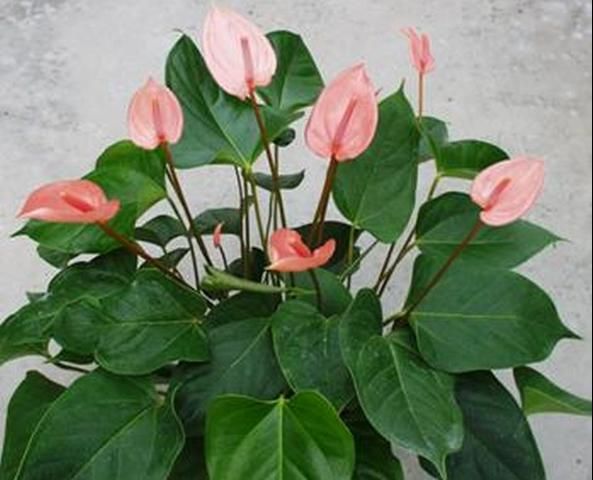Anthurium (Anthurium andreanum Linden ex Andre (Family:Araceae) has historically been bred, developed and grown for cut flower production. The showy red, orange, pink or white spathes are prized as exotic, high-value cut flowers (Kamemoto and Kuehnle 1996). The large overall plant size, long petioles and tall peduncles of the cut flower varieties generally preclude their use as containerized potted plants. Since the beginning of the millennium, however, new Anthurium varieties have been developed to emphasize a smaller overall plant size combined with a highly prolific flowering habit. This new direction is intended for flowering potted plant production. Anthurium X 'Red Hot' was one of the first such hybrids that produced numerous, attractive, bright red spathes and a compact, well-branched growth habit (Henny 1999). Anthurium X 'Orange Hot' is a mutation found in a large population of tissue cultured, propagated A. 'Red Hot'. The mutation was collected and tested as part of the Foliage Plant Breeding and Genetics Research Program at that UF/IFAS Mid-Florida Research and Education Center—Apopka.

Description
Mature leaves of a one year old 'Orange Hot' plant are lance-shaped, 18 to 20 cm (7.2 to 8 in.) in length and 9 to 11 cm (3.6 to 4.4in.) wide at the widest part. The upper surface leaf color is dark green (RHS 146B-C; Royal Horticultural Society, 1995). The underside of the leaf is a lighter green (RHS 139A). Petioles are uniform yellow-green (RHS 146B-C). Anthurium 'Orange Hot' produces spathes that are 6 to 7 cm (2.4 to 2.8 in.) long and 4 to 5 cm (1.6 to 2.0 in.) wide. They are held on peduncles 25 to 35 cm (10 to 14 in.) tall that locate the inflorescences higher than the leaf canopy where they are easily seen and enjoyed. When they unfurl, new spathes are a light salmon orange color (RHS 39B-C), and they gradually fade over a period of two to three weeks to a lighter orange (RHS 36B-C). The spadix at anthesis is a light orange color (RHS 38A) at the base and increases in intensity to orange (RHS 39A-B) at the apex. In older flowers, the spadix becomes a uniform lighter orange color (RHS 37D). Peduncles are yellow green at the base (RHS 152A-B) and darken to grayed-orange (RHS 172D) near the spathe.
Performance
Performance characteristics of Anthurium X 'Orange Hot' were determined in a growth study. Thirty liners were selected from well-rooted cuttings in 25-mm (72 insert) cell trays. Liners were potted into 1.6L (6-inch) plastic pots containing a growing medium of 3:2 Canadian peat: perlite by volume. The soil was amended with 0.9 kg m-3 of Micromax, (Sierra Chemical Company, Milpitas, CA) and 4.1 kg m-3 dolomite. Plants were grown in a shaded greenhouse with a maximum irradiance of 125µmol s-1m-2 under a natural photoperiod and a temperature range of 15°C to 34°C (63°F to 97°F). Ten plants were grown at each of three fertilizer levels. The fertilizer was applied as a liquid at 100ml/pot per week. Fertilizer levels were derived from stock solutions made in a 3N-1P-2K ratio. The test was set in a completely randomized design. At the end of the test, data recorded canopy height and width, length and width of largest leaf and number of open flowers. Plants were also rated for visual quality on a scale of 1 to 5, where 1 = dead, 3 = acceptable, saleable and 5 = excellent quality.
Anthurium X 'Orange Hot' reached marketable size in 7 months. Fertilizer level did not significantly affect any of the variables measured except canopy width, which increased linearly as fertilizer levels increased (Table 1). All plants were rated between good and excellent at each fertilizer level. Overall plant quality averaged 4.2 out of a possible 5.0. Mature plants were wider than they were tall. Both primary and secondary shoots bloomed resulting in average flower counts of four to five per plant. Plants were well branched. Canopy height and width averaged 20.4 cm by 42.9 cm (8.2 by 17 inches) for the 1.6L (6-inch) pot size. For additional details the reader is referred to the 2003 'Orange Hot' Anthurium article in HortScience (Henny et al. 2003).

Availability
Anthurium X 'Orange Hot' is intended for commercial producers growing finished plants in 1.6 or 3.9L (6-inch or 8-inch) containers. Stock plants have been released to University of Florida licensed cooperating Florida tissue culture labs for propagation and distribution. Inquiries regarding participating labs may be obtained by writing the Florida Foundation Seed Producers, Inc., PO Box 309, Greenwood, FL 32443. Plants for research purposes may be obtained directly from the author.
References
Henny R. J , D.J. Norman, and J. Chen. 2003. 'Orange Hot' Anthurium. HortScience, Vol. 38(1):133–134.
Henny R. J , and D.J. Norman. 1999. 'Red Hot' Anthurium. HortScience, Vol. 34(1):153–154.
Kamemoto, H. and A.R.Kuehnle. 1996. Breeding Anthuriums in Hawaii. Univ. of Hawaii Press. 132p.
Royal Horticultural Society. 1995. The Royal Horticultural Society Colour Chart. 3rd ed. Royal Horticulture Society, London.